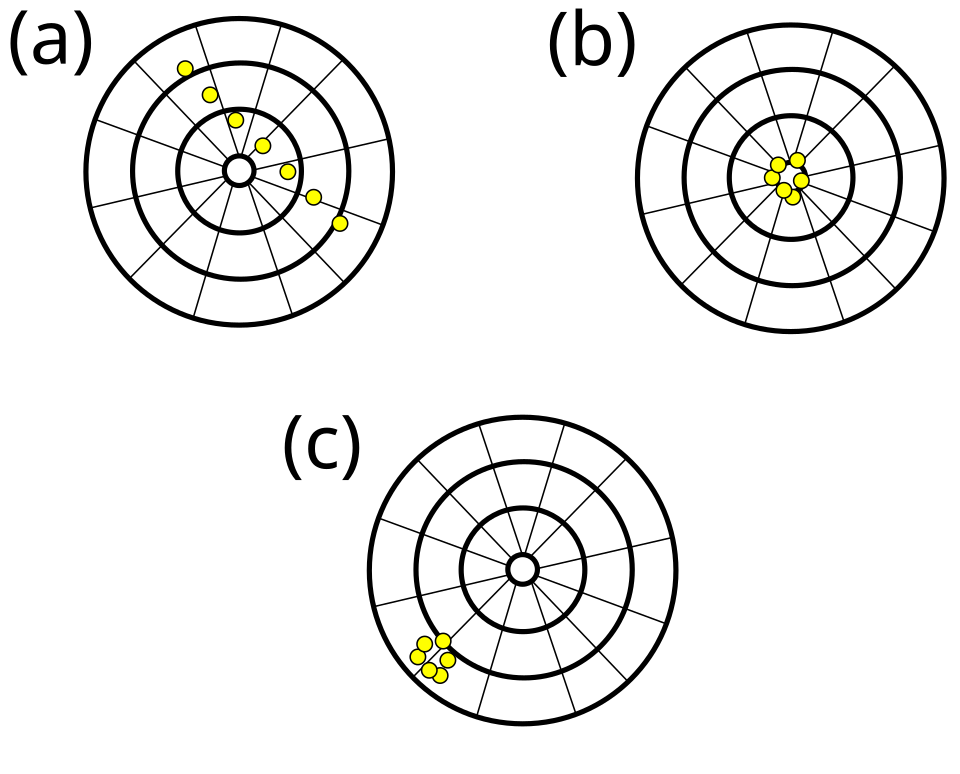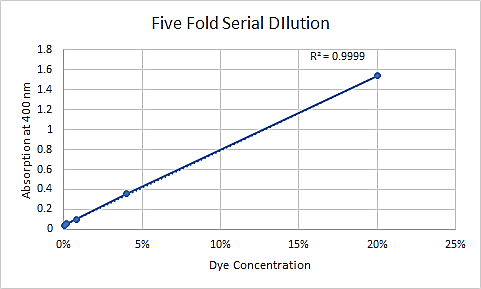OCR Specification focus:
‘Explain the limitations and weaknesses of experimental procedures used, including potential sources of bias.’
A good evaluation must recognise how experimental design and technique restricts data quality. Students must judge weaknesses, identify potential bias and decide how limitations influence confidence in results.
Understanding limitations of procedures
Limitations in biology experiments arise when methods, equipment or researcher decisions reduce the validity, accuracy, precision, or reliability of data.

A comparison of accuracy and precision using target diagrams. High precision but low accuracy indicates systematic error, while low precision shows random error affecting reliability. Source.
These limitations affect how strongly conclusions can be supported by evidence. Validity is the extent to which results measure what is intended, while reliability describes the consistency of repeated results under identical conditions.
When evaluating a procedure, students must judge how the method might distort outcomes, whether biological variables were properly controlled, and how far weaknesses could have influenced the dependent variable.
Types of procedural limitations
Procedural limitations can occur at multiple stages of an investigation. Common categories include:
Uncontrolled variables affecting validity
Inadequate control groups reducing certainty of causation
Imprecise equipment creating wide uncertainty
Sampling limitations that reduce representativeness
Operator error and subjective judgement
Bias, including unconscious experimenter influence
Low repeatability preventing reliable pattern detection
Environmental fluctuation altering biological responses
Each source limits confidence in the biological conclusions and must be acknowledged when interpreting data.
Control variables and incomplete standardisation
When key conditions are not tightly controlled, the dependent variable may be influenced by factors other than the independent variable. For example, uncontrolled temperature, pH, or light intensity can introduce systematic effects, shifting all measurements in one direction. This reduces validity and prevents confident attribution of a biological cause.
Sampling limitations and biological variability
Biological systems are inherently variable, so sampling weaknesses significantly limit data quality. Small sample sizes increase the influence of outliers, while non-random sampling introduces selection bias, where individuals or samples are not representative of the whole population.
Bias: A systematic deviation in data caused by consistent favouring of one outcome, leading to reduced validity.
Poor sample selection lowers confidence that findings apply beyond the specific organisms or cells tested. A single specimen, culture, or trial cannot capture natural biological variation.
Measurement limitations and apparatus constraints
Many school-level instruments, such as light microscopes, timers and measuring cylinders, have limited resolution, reducing precision. Low-resolution equipment produces wide uncertainty, making it harder to detect real trends. Furthermore, calibration errors can cause systematic shifts in results if apparatus does not measure true values.

A standard calibration curve showing how measured responses relate to known concentrations. Deviations from linearity or poor calibration introduce systematic error that limits the validity of experimental data. Source.
Subjective decision-making, such as judging the end-point of a colour change, is also a measurement limitation, as it introduces human judgement instead of numerical objectivity.
Repeatability and reproducibility
Reliable investigations must produce similar results when repeated. Repeatability refers to consistency within the same laboratory and experimenter, whereas reproducibility refers to consistency across different laboratories or researchers. Limited repeats reduce statistical confidence, making it unclear whether patterns are genuine or due to chance.
Sources of experimental bias
Bias can influence results through expectation or experimental conditions. Major causes include:
Observer bias, where prior expectations alter measurement judgement
Instrument bias, linked to mis-calibrated equipment
Selection bias, through non-random sampling
Confirmation bias, where results supporting predictions are favoured over contradictory data
Procedures that fail to minimise bias weaken validity and can distort biological interpretation. Blinding, randomisation, and objective measurements are important in reducing bias, but many school experiments lack these protections, creating unavoidable limitations.
Environmental and biological constraints
Biological responses are sensitive to environment, meaning minor fluctuations can alter outcomes. Variability in organism health, age, or stress state acts as a procedural limitation because these factors cannot always be fully controlled. For living samples, ethical restrictions and practical constraints also limit the range of possible tests, introducing gaps in data collection and interpretation.
Recognising weaknesses when writing evaluations
When discussing limitations, students should:
Identify the specific procedural weakness
Explain how it affects data (e.g., reduces precision, introduces bias, or lowers validity)
Link the limitation to its impact on confidence in the conclusion
Clear evaluation demonstrates understanding of how scientific investigations generate evidence, not just the biological content being studied. By recognising limitations of procedures, students meet the OCR requirement to assess weaknesses, identify bias, and judge how far results can be trusted.
FAQ
A limitation is a weakness in the design or procedure that restricts how confidently a conclusion can be made. It exists even if measurements are technically correct.
An error is a mistake made during data collection, such as misreading a scale. Uncertainty refers to the range within which the true value lies due to equipment resolution. An experiment can be error-free but still have limitations that reduce validity.
Bias can be reduced through procedural choices, even when equipment is basic. Students can:
• Randomise sample order to avoid pattern-based bias
• Use blinding so the observer does not know the expected outcome
• Standardise timing and conditions to reduce directional shifts in data
These steps limit bias by reducing the influence of expectations and external variables.
Subjective measurements vary between observers and across repeats, reducing reliability and precision.
Many biological endpoints (for example, colour changes or counting moving organisms) rely on personal judgement. Since results depend on human perception instead of an objective scale, variations cannot be accurately controlled, making trends harder to interpret confidently.
Biological systems show natural variation between organisms, even under identical conditions. Factors such as age, health, and genetic differences can all influence results.
While physical variables like temperature or pH can usually be standardised, biological variability can only be minimised, not eliminated, making it a stronger limitation in many investigations.
Living organisms produce data with high variation due to differences in behaviour, metabolism, or stress responses.
Repeating tests and increasing sample size helps:
• Smooth out unpredictable changes
• Reduce the impact of anomalies
• Improve confidence that patterns are real, not random
This ensures conclusions are supported by consistent biological trends rather than isolated observations.
Practice Questions
Question 1 (2 marks)
A student states that their results are unreliable because only one repeat was taken for each measurement. Explain why this is a limitation.
Question 1 (2 marks)
Award 1 mark for each valid point:
• With only one repeat, anomalies cannot be identified (1)
• Lack of repeats reduces reliability because the consistency of data cannot be confirmed (1)
Question 2 (5 marks)
A student investigates the effect of light intensity on the rate of photosynthesis using pondweed. The experiment is carried out in an open laboratory with changing room temperature. The student measures the volume of gas produced but judges the end-point of each reading by eye. Discuss the limitations of this procedure and how they could affect the confidence in the student’s conclusions.
Question 2 (5 marks)
Award 1 mark for each of the following, up to 5 marks:
• Room temperature is not controlled, so another variable may influence the rate and reduce validity (1)
• Changes in temperature introduce a systematic effect or uncontrolled variable affecting confidence in causation (1)
• Judging the end-point by eye introduces subjective judgement, reducing precision (1)
• Gas volume measurements are less reliable due to human error or bias (1)
• Limitations make trends less certain, reducing confidence in the conclusion because the effect may not be due to light intensity alone (1)

